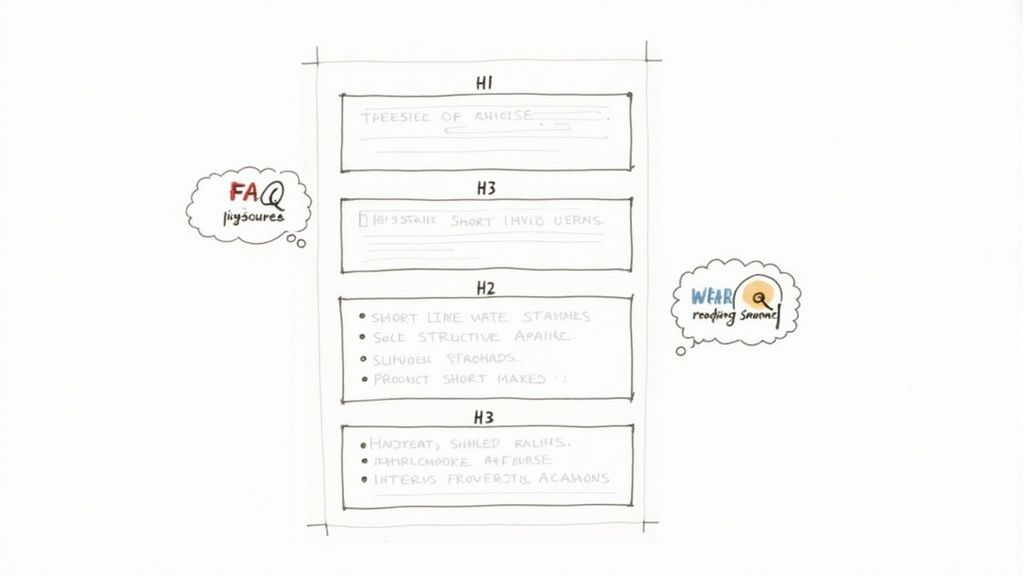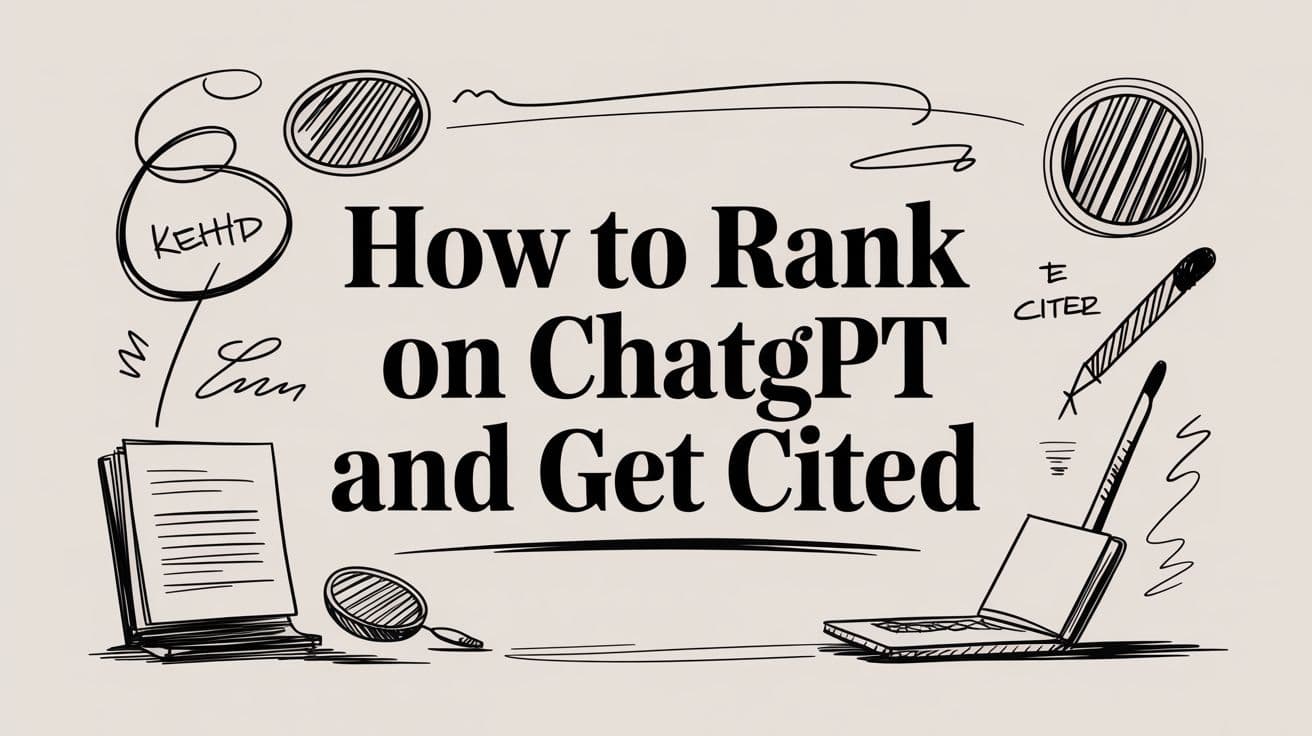Getting your content into ChatGPT isn’t about climbing a search ladder. It's about becoming a citable, trusted authority. Your goal is to create content so clear and well-structured that an AI chooses it to build its answers, often by pulling from sources that already rank well on Google.
Why "Ranking on ChatGPT" Is the Wrong Goal
AI models like ChatGPT don't have a "position one." There is no ladder to climb.
Instead, they act as synthesizers. When a user asks a question, the AI generates a new answer by weaving together information from its training data and live web searches. Your content "ranks" by being selected as a credible source for that final, synthesized answer.
Your new goal is to become citable.
This means positioning your content as the most reliable, accurate, and easily digestible source on a specific topic. You want the AI to see your work and decide, "This is the definitive answer I need."
The Unavoidable Google Connection
You can't ignore traditional SEO. Since ChatGPT often uses Google’s index to fetch real-time information, your existing search performance provides a massive head start. Content that already ranks well is more likely to be seen and trusted by the AI.
Think of it this way:
- A Signal of Authority: A high Google ranking is a powerful trust signal. It tells the AI that humans already find this content valuable.
- A Primary Information Source: For fresh data, AI models perform live searches. Your well-ranked page is a prime candidate to be pulled into the results.
- Semantic Understanding: The work you did optimizing for semantic search on Google directly helps AI models grasp your content's context and relevance.
This process is a core part of a modern strategy called Answer Engine Optimization, where the objective is to be the definitive answer wherever users are asking questions.
How Google SEO and ChatGPT Visibility Differ
| Factor | Traditional Google SEO Goal | ChatGPT Visibility Goal |
|---|---|---|
| Primary Objective | Rank a specific URL as high as possible in the SERPs. | Get your information and brand cited within an AI-generated answer. |
| User Interaction | Drive a click from the search results to your website. | Have your key points absorbed directly within the chat interface, with a potential click-through for more detail. |
| Content Focus | Target keywords and satisfy search intent to match a query. | Provide clear, factual, well-structured information that's easy for a machine to parse and synthesize. |
| Success Metric | High keyword rankings (e.g., Position #1). | High citation frequency and inclusion in AI-generated answers. |
This table highlights the fundamental shift: you're moving from a page-ranking game to an information-sourcing game. Your content becomes a dataset for the AI.
The Data Shows Where to Focus
This connection to Google isn't absolute. While a 2024 SEJ study found 76.1% of URLs cited in AI Overviews rank in Google's top 10, other data reveals that ChatGPT cites lower-ranking pages (positions 21+) about 90% of the time. You can find more of these insights in the 2025 AI SEO statistics at position.digital.
This data tells a clear story. Top Google rankings provide a strong advantage, but highly relevant, well-structured content from deeper in the search results can still win a citation if it perfectly matches the user's intent.
Your strategy must be two-fold. First, build a strong SEO foundation to get on the AI's radar. Second, structure your content specifically for machine comprehension, ensuring that when an AI does find your page, it can easily parse your information.
First, Build Your Foundation with Google SEO

The fastest way to get cited by ChatGPT is to improve your Google presence. AI models, especially when pulling live data, lean heavily on the search index you already know. A solid Google ranking is your ticket to the game.
When your content ranks in the top 5 for a query, it tells the AI that humans already find it valuable and authoritative. That credibility makes your content a low-risk, high-quality choice for the AI to synthesize into an answer.
Prioritize Topical Authority Over Single Keywords
Getting an AI citation isn't about winning one high-traffic keyword. It's about proving you have deep expertise across an entire subject. This concept, known as topical authority, is what separates a thin article from a resource an AI will trust.
Stop writing isolated articles. Start building content clusters.
Connect your pages with smart internal links that show how all your knowledge fits together. For example, if you are a B2B SaaS company aiming for "best CRM for small business," you also need comprehensive content on:
- How to implement a CRM for the first time
- Integrating a CRM with email marketing tools
- Case studies of small businesses succeeding with their CRM
This interconnected web of content proves your expertise beyond a single keyword. It makes your entire domain a more attractive source for an AI model. To get there, you have to nail traditional SEO first. Learning how to improve Google search rankings lays the groundwork for everything else.
Google Is Still the Gateway to the Web
Even with the growth of AI chatbots, Google remains the center of the web. The connection between old-school SEO and getting seen on ChatGPT is undeniable. Data from 2025 shows that about 95% of ChatGPT users still visit Google, while only 14% of Google searchers use ChatGPT.
Google's staggering 83.8 billion monthly visits dwarf ChatGPT’s 5.8 billion. It’s still the web's primary information gateway. Since ChatGPT often pulls live information from Google's index, a strong presence there directly feeds your AI visibility. Your existing SEO efforts are not wasted; they are the bedrock of your AI optimization strategy.
Your SEO Checklist for AI Visibility
To make your content irresistible to AI models crawling Google, focus on these core fundamentals.
- Build High-Quality Backlinks: Get links from other authoritative sites in your space. A single link from a respected industry blog is a massive vote of confidence.
- Keep Content Fresh and Accurate: Regularly update your articles with new stats and information. An AI is programmed to avoid citing outdated content.
- Optimize for E-E-A-T: Prove your expertise. Add author bios with real credentials, cite original data, and present a balanced, trustworthy point of view.
When you master these SEO pillars, you're building a library of trustworthy, citable content that AI models will feature.
Second, Structure Your Content for Machine Comprehension

AI models don’t read your articles. They parse them. They rip your content apart into machine-readable chunks, hunting for the most relevant facts. If you want to get cited, you have to build your content for a machine's brain, not just for human eyes.
This is different from basic on-page SEO. It’s about creating a logical flow that an algorithm can follow. Think of it as handing the AI a blueprint to your content. A clear structure makes your information easy to extract, which is the first step to getting chosen as a source.
Build a Machine-Readable Blueprint
The architecture of your content signals what’s important to AI crawlers. A messy page is confusing, but a well-organized one gives the AI clean pathways to the information.
Start with these fundamentals:
- Hierarchical Headings: Use a single H1. Follow it with H2s for main sections, and H3s for sub-points. This creates a logical outline an AI can instantly understand.
- One Idea Per Paragraph: Keep your paragraphs tight—no more than three sentences. Each one should focus on a single concept.
- Lists and Tables: Don't bury data in dense text. Use bullet points, numbered lists, and tables for comparisons, steps, or feature breakdowns.
Mini Case Study #1: A Simple Formatting Win A travel blog I consulted had a dense paragraph about "what to pack for Lisbon." I had them reformat it into a simple bulleted list broken down by season. Within two weeks, ChatGPT started pulling that exact list into its answers for packing-related questions, citing their blog every time. The content was the same, but the structure made it citable.
The goal is to eliminate all ambiguity. When your content is perfectly structured, an AI doesn’t have to guess what matters—you’ve already told it.
Use Schema Markup to Speak the AI's Language
Schema markup is the single most powerful tool for helping an AI understand your content. It’s code you add to your site that explicitly tells search engines and AI models what your content is about. It's like putting labels on all your data so the machine knows exactly what it's looking at.
You don't have to be a coder to implement it. Tools, including some AI writing assistants like Jasper AI, can help generate and format this structured data.
Focus on High-Impact Schema Types
To get your content used by AI models, certain schema types are more effective than others. I've found focusing on these makes the biggest difference.
| Schema Type | What It Does | Example Use Case |
|---|---|---|
| FAQPage | Packages questions and their answers into a neat, machine-readable format. | A product page answering common customer questions like "What is your return policy?" |
| HowTo | Breaks down a process into a clear, sequential series of steps. | A blog post detailing the steps to "bake the perfect sourdough bread." |
| QAPage | Structures a single question followed by one or more user-submitted answers. | A forum thread where users answer, "What's the best hiking trail near Denver?" |
| Article | Defines key elements of a blog post, such as the author, headline, and publication date. | Any standard blog post or news story on your website. |
| Recipe | Marks up recipe-specific information like ingredients, cook time, and nutritional facts. | A food blog sharing a recipe for "quick weeknight lasagna." |
Implementing just a couple of these schema types is like translating your content into a language AI models speak fluently. By adding this layer of structure, you aren't just hoping the AI understands you—you're guaranteeing it. To see what an AI crawler is pulling from your page, run it through a tool like our AI Page Inspector to check if your structure is working.
Third, Write Direct Answers to User Prompts
To show up in an AI answer, you must think like the person asking the question. Getting your content cited by ChatGPT requires a shift in strategy to anticipate and directly answer the prompts users are typing into that chat window. This isn't about breadth; it's about precision.
Instead of writing a broad article on "The Benefits of CRM Software," you create a laser-focused piece answering, "Which CRM is Best for a Real Estate Agency?" That single shift moves you from being background noise to a specific, citable solution.
Find Prompts, Not Just Keywords
Your keyword research process needs an overhaul. For AI, you have to get inside the head of someone having a conversation. This is prompt-based research.
Think about the natural language your ideal customer uses when talking to an AI assistant. They aren’t typing disjointed keywords; they're asking full questions.
Your research needs to uncover prompts exactly like these:
- "Compare HubSpot vs Salesforce for a team of 10"
- "What are the essential features of a project management tool for a remote team?"
- "How do I create a content calendar from scratch?"
Focusing on these long-tail, intent-driven questions is how you align your content with what the AI is actively looking for to solve a user's problem.
Build the Definitive Answer for That Prompt
Once you've found a high-value prompt, your job is to create the most comprehensive, clear, and well-structured answer to it on the internet. Go deep.
The most citable content often feels like a mini-encyclopedia entry for a very specific problem. It leaves no stone unturned and presents information so logically that an AI can easily parse and reference it.
Recent data backs this up. Analysis shows that about 31% of ChatGPT prompts trigger web searches, especially for queries with terms like "reviews," "comparison," and "features." There's only about a 10% overlap between ChatGPT's short-tail search results and Google's top SERPs. This means AI often surfaces content that traditional SEO completely overlooks. You can find more on these patterns and how they shape AI content strategy on keywordseverywhere.com.
This data proves that if you create the best comparison or review page for a specific niche, you have a solid chance of being cited, even if you don't have a top Google ranking.
Mini Case Study #2: A Prompt-Driven Strategy A travel blog published general guides like "Why You Should Visit Lisbon." They were well-written but generic, and they saw zero AI citations.
We flipped their strategy to focus on specific user prompts. They created new articles that directly answered questions like:
- "Is a 3-Day Trip to Lisbon Enough to See Everything?"
- "Best Day Trips from Lisbon by Train"
- "What is the Average Cost of a Meal in Lisbon?"
Each article used the prompt itself as the H2. The results were almost immediate. Within weeks, their new content started appearing as cited sources in ChatGPT answers. They perfectly matched a user's specific query with a purpose-built, easily digestible answer. They became a specific, trusted authority.
Your Action Plan for ChatGPT Visibility
Knowing the strategy is one thing, but turning it into a plan gets results. This isn't about a massive site-wide overhaul. It's about making targeted adjustments to frame your content as the go-to source for AI. The core idea is to make your information so clear, structured, and authoritative that an AI model has no choice but to cite you.
Your path to learning how to rank on ChatGPT is a continuous loop: audit your existing content, create new content with AI in mind, and track what’s working.
Audit and Refine Existing Content
Your current content library is a goldmine. Before writing a single new word, look at your highest-performing articles through an "AI lens."
- Deconstruct Paragraphs: Find long, dense paragraphs and break them into single-idea sentences. An AI is far more likely to pull a concise, self-contained sentence.
- Strengthen Headings: Rewrite vague H2s and H3s into specific questions. Instead of "Key Features," change it to "What Are the Key Features of X Software?" This directly mirrors user prompts.
- Add Structured Elements: Turn walls of text into bulleted lists, numbered steps, or simple tables. If you explain a three-step process, format it that way.
This workflow is simple: find user prompts, build content that answers those exact questions, and format it so a machine can easily read it.
Create with AI as Your Secondary Audience
When you develop new content, your primary audience is still human. But your secondary audience is the machine. This means building every new article with clear signposts for AI from the start.
The goal is to be radically useful and structurally perfect. Provide an answer so comprehensive and well-organized that it becomes the definitive resource for that specific user prompt, making it an easy choice for an AI citation.
A financial software company did this perfectly. They wanted to get cited for prompts like "best budgeting apps for freelancers." They created an article with a detailed comparison table, a dedicated FAQ section marked up with schema, and H3s for each app that broke down the pros and cons. They didn't just write an article; they built a structured dataset.
Track and Measure Your Success
You can't improve what you don't measure. Tracking your visibility in AI-generated answers is different from your standard SEO report, but it's just as critical. You have to know which of your pages are getting cited and for what kinds of prompts.
- Monitor Referral Traffic: In your analytics, set up filters to track traffic from sources like
openai.com. A sudden spike often signals a new citation. - Manually Test Prompts: Every so often, query ChatGPT and other models with your target prompts. See if your brand appears. Check who your competitors are and what sources are being cited.
- Use Citation Analysis Tools: This is the most reliable method. A dedicated platform is a significant advantage. Understanding the best citation analysis options for optimizing AI search is critical for pinpointing which pieces of your content are resonating with different AI models.
This three-part framework—Audit, Create, Track—gives you a repeatable process for improving your AI visibility. Start small. Audit your top five blog posts this week, create one new piece of content built for AI, and set up a basic tracking dashboard. This is how you start to win.
Frequently Asked Questions
Got a few more questions about getting your content noticed by ChatGPT? Here are straight answers to the most common ones.
Can I just pay to get my content cited by ChatGPT?
No. You can't pay to play in ChatGPT's organic answers. Just like with Google's organic search results, visibility here is earned through relevance and authority, not your ad budget.
ChatGPT’s value is synthesizing what it believes to be the best, most accurate information. Taking money for citations would destroy that credibility. The only way in is to create the most helpful resource and structure it so the AI can understand its value.
Does my Domain Authority score actually matter?
Yes and no. It matters, but probably not in the way you're thinking. A high Domain Authority (DA) is a symptom of the things that truly matter to an AI: a solid backlink profile, deep topical expertise, and a history of publishing trustworthy content.
An AI model isn't logging into Moz or Ahrefs to check your score. What it does see are the signals that create that high score—namely, that lots of other reputable sites are linking to you as a source. While DA itself isn't a direct ranking factor for AI, the foundational SEO work that builds a high DA is absolutely essential.
How long until I see results after optimizing my content?
This isn't an overnight fix. How quickly you see results depends on two things: how often your site gets crawled and the AI model's own update cycles.
- For high-authority sites: If search engines already crawl your site frequently, your changes might get picked up and reflected in AI answers within a few weeks.
- For lower-authority sites: Be prepared to wait a few months. Your optimized content first needs to gain traction in traditional search indexes before AI models start trusting it.
Patience is key. This is a long-term strategy built on consistently creating clear, authoritative content.
Will getting cited by AI actually drive sales?
It can, but the path isn't a straight line. Getting cited by ChatGPT is primarily about building brand awareness and cementing your reputation as an expert.
Imagine a potential customer asks, "What's the best accounting software for freelance writers?" In its response, ChatGPT mentions your product and cites your blog post comparing the top options.
- The immediate win is brand exposure. That user now connects your name with a solution.
- They might not click through and buy right then, but you're now on their radar.
- This kind of top-of-funnel awareness is incredibly valuable. It often leads to them searching for your brand directly later on, which contributes to sales.
Think of AI citations as a powerful, modern form of digital PR. It builds the credibility that pays off over time.
AI SEO Tracker shows you exactly which prompts your brand is ranking for in AI answers. Stop guessing and start measuring your visibility in ChatGPT, Gemini, and more. Our platform helps you discover high-intent questions, track your AI share of voice against competitors, and get a clear action plan to earn more citations. See how we can help you capture demand at https://aiseotracker.com.

